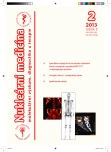Specification of Equivocal Lesions in Planar Whole Body Bone Scintigraphy with SPECT/CT in Oncological Patients
Authors:
Ladislav Zadražil () 1,2,3; Petr Libus () 1
Authors‘ workplace:
Oddělení nukleární medicíny, Nemocnice Havlíčkův Brod, p. o.
1; Radiodiagnostické oddělení, Nemocnice Havlíčkův Brod, p. o.
2; Radiologická klinika, LF MU Brno
3
Published in:
NuklMed 2013;2:25-30
Category:
Original Article
Overview
Aim:
To determine how often SPECT/CT is needed to specify the abnormal finding in a planar WB bone scan, whether comparison with the previous scan is useful, in how many cases SPECT/CT gives a definitive diagnosis, and how many foci are found in bone scan in benign and malignant affections.
Patients and method:
We studied retrospectively 471 WB scans in 450 patients with breast, lung and prostate cancers, who underwent bone scintigraphy in 2008. SPECT/CT or CT was used in 11,9 % examinations of 12,4 % patients. Repeated scintigraphy (319 patients after bone scintigraphy and 36 patients after SPECT/CT) were used as a reference examination.
Results:
Comparison with previous scintigraphy was useful in patients with breast cancer before SPECT/CT was indicated. SPECT/CT could specify equivocal lesions in 90,9 % cases. The sensitivity, specificity, positive and negative predictive values of the CT in SPECT/CT for detection of bone metastases were 72,8 %, 96 %, 88,9 % and 88,9 %, respectively. No significant difference between the group with one and without any suspected lesions in WB scan in the development of metastatic disease in 2 years was proven (p = 0,4272), but if more uncertain foci in the bones were detected, the malignant origin should be taken into consideration (p ≤ 0,0001).
Conclusion:
SPECT/CT improves specificity of bone scintigraphy. It seems to be reasonable to consider SPECT/CT in 10-20 % of all cases after comparison with previous bone scan. The CT guided by WB scan adds a relatively small radiation dose to that from scintigraphy, 13 % in a collective effective dose in our study.
Key Words:
bone scintigraphy, bone metastases, SPECT/CT
Sources
1. Body JJ. Metastatic bone disease. In: Seibel MJ, Robins SP, Bilezikian JP Eds. Dynamics of Bone and Cartilage Metabolism: Principles and Clinical Applications - 2nd edition. San Diego, N.Y., Boston, London, Sydney, Tokyo, Toronto, Academic Press, 2006, 920 p
2. Galasko CSB. Skeletal metastases. Clin Orthop Rel Res 1986;210 : 18-30
3. Coleman RE, Rubens RD. The clinical course of bone metastases from breast cancer. Br J Cancer 1987;55 : 61-66
4. Kamby C, Vejborg I, Daugaard S et al. Clinical and radiologic characteristics of bone metastases in breast cancer. Cancer 1987;60 : 2524-2531
5. Barwick T, Fernando R, Gnanasegaran G et al. The use of 99mTc-MDP SPECT/CT in the evaluation of indeterminate bone lesions on whole body planar imaging in cancer patients. Eur J Nucl Med Mol Imaging 2008;35(Suppl 2):S154
6. Elgazzar AH. Neoplastic bone disease. In: Elgazzar AH. Orthopedic Nuclear Medicine - 1st edition. Berlin, Heidelberg, N.Y., Springer, 2004, 240 p
7. Ron IG, Striecker A, Lerman H et al. Bone scan and bone biopsy in the detection of skeletal metastases. Oncol Rep 1999;6 : 185-188
8. Yildiz M, Oral B, Bozkurt M et al. Relationship between bone scintigraphy and tumor markers in patients with breast cancer. Ann Nucl Med 2004;18 : 501-505
9. Nicolini A, Ferrari P, Sagripanti A et al. The role of tumour markers in predicting skeletal metastases in breast cancer patients with equivocal bone scintigraphy. Br J Cancer 1999;79 : 1443-1447
10. Kohlfürst S, Lobnig M, Matschnig S et al. Impact of SPECT-CT performed in case of inconclusive findings on planar whole body bone scintigraphy in patients with a history of breast or prostate cancer. Nuklearmedizin 2009;48:A147-A148
11. Hoeschen C, Regulla D, Zankl M et al. Radiation exposure and protection in multislice CT. In: Reiser MF, Becker CR, Nikolaou K et al. Eds. Multislice CT - 3rd edition. Berlin, Heidelberg, Springer, 2009, 628 p
12. Römer W, Nömayr A, Uder M et al. SPECT-guided CT for evaluating foci of increased bone metabolism classified as indeterminate on SPECT in cancer patients. J Nucl Med 2006;47 : 1102-1106
13. Horger M, Eschmann SM, Pfannenberg C et al. Evaluation of combined transmission and emission tomography for classification of skeletal lesions. AJR 2004;183 : 655-661
14. Even-Sapir E, Metser U, Mishani E et al. The detection of bone metastases in patients with high-risk prostate cancer: 99mTc-MDP planar bone scintigraphy, single - and multi-field-of-view SPECT, 18F-fluoride PET, and 18F-fluoride PET/CT. J Nucl Med 2006;47 : 287-297
15. Tomoda Y, Ishino Y, Nakata H. Assessment of solitary hot spots of bone scintigraphy in patients with extraskeletal malignancies. Jpn J Nucl Med 2001;38 : 721-726
16. Jacobson AF, Cronin EB, Stomper PC et al. Bone scans with one or two new abnormalities in cancer patients with no known metastases: frequency and serial scintigraphic behavior of benign and malignant lesions. Radiology 1990;175 : 229-232
17. Even-Sapir E. Imaging of malignant bone involvement by morphologic, scintigraphic, and hybrid modalities. J Nucl Med 2005;46 : 1356-1367
18. Buck AK, Nekolla S, Ziegler S et al. SPECT/CT. J Nucl Med 2008;49 : 1305-1319
Labels
Nuclear medicine Radiodiagnostics RadiotherapyArticle was published in
Nuclear Medicine

2013 Issue 2
Most read in this issue
- Ewing sarcoma - scintigraphic image
- Brief overwiev of individually prepared radiopharmaceuticals in laboratory on KNME FN Motol Prague
- Specification of Equivocal Lesions in Planar Whole Body Bone Scintigraphy with SPECT/CT in Oncological Patients
- What can you see on the image?
